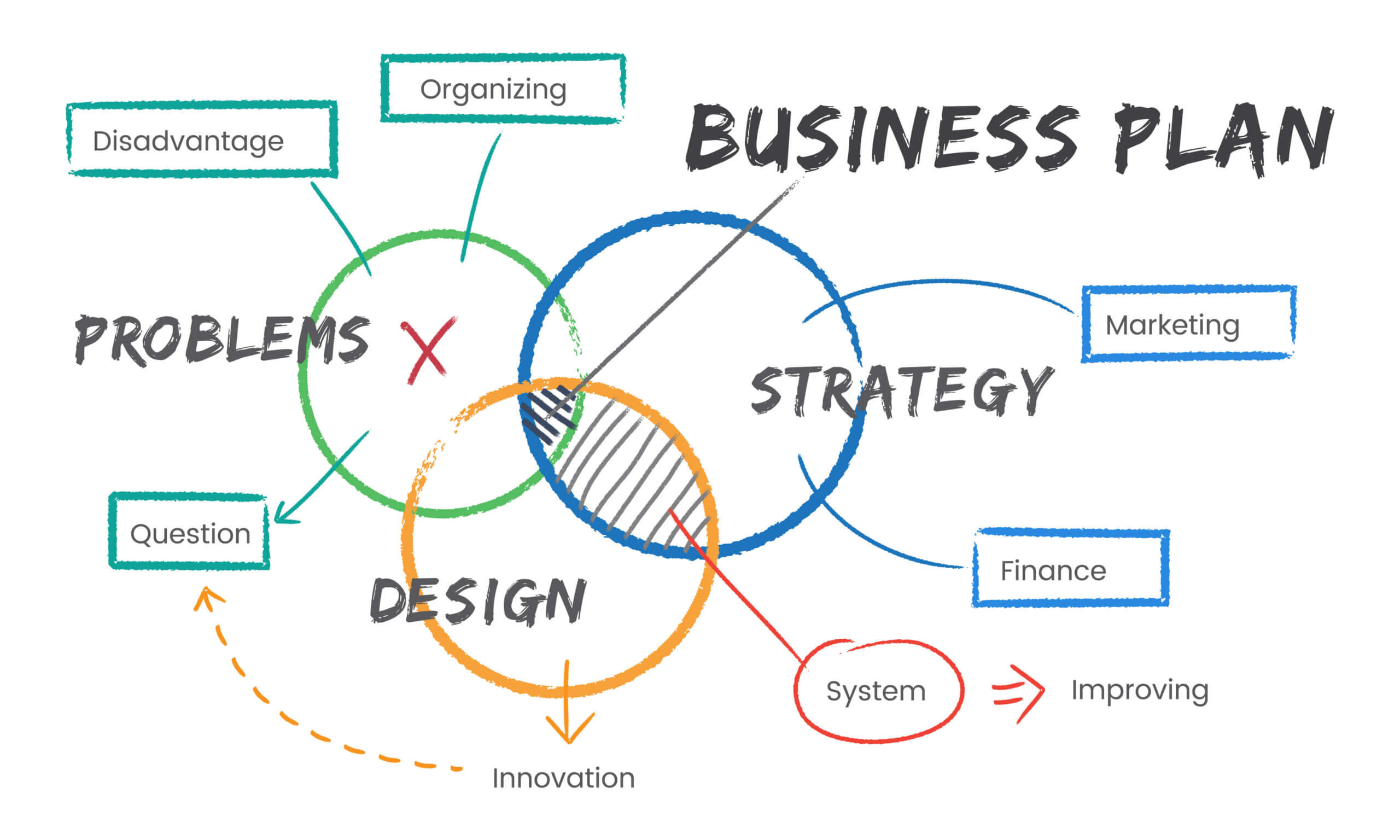In a previous blog, I described “value chain” analysis, which is an analytical technique designed by Michael Porter to evaluate the sequence of business activities to improve profitability. Those five areas are: inbound logistics, operations, outbound logistics, marketing & sales, and service. That leads to a review of cost advantages and areas of differentiation for your firm. Continue reading “Case Study: Value Chain Improves Profitability”
The Drivers Model: The Secret to Facilitating Strategy
Leadership Strategies has developed the Drivers Model, a method for taking a strategic approach to addressing a business situation. The model provides a simple communication tool for helping organizations construct a strategic plan. The model is fully scalable and applies to Fortune 500 companies, non-profit organizations, a field office, an individual department, a work team, etc.
There are four major steps in our standard Drivers Model. What follows is a brief overview of the four steps.
Step 1: Where are we now? (Situation Assessment)
Understanding the current situation is vital to identifying the approaches needed to drive success. A full understanding of the current situation includes an analysis of several areas. The list below shows a sample list of assessment areas and one or two of the key questions to be answered for each.
Step 2. Where do we want to be? (Strategic Direction)
The heart of strategic direction setting is this second step. In our Drivers Model, the information from the situation assessment is combined with the understanding of future trends to develop the vision statement and the mission statement.
Step 3 – How do we plan to get there? (Implementation Planning)
Once the objectives are established, the next step is to develop the road map for achieving the direction. For the road map to be viable, however, it must focus on three areas in particular.
Step 4 – How will we monitor progress? (Monitoring)
Many organizations benefit simply from going through the process of creating a strategy. At this point, everyone is clear on where we are going and how we plan to get there. However, the key value to strategy development comes in the implementation of the plan. Unfortunately, all too often, strategic plans become space fillers on an executive’s bookshelf. To prevent this occurrence, we recommend a structured monitoring process every three-to-six months.
__________________________
Michael Wilkinson is the CEO and Managing Director of Leadership Strategies, Inc., “The Facilitation Company” and author of Amazon best-seller “The Secrets of Facilitation”, “The Secrets to Masterful Meetings”, and the brand new “The Executive Guide to Facilitating Strategy.” Leadership Strategies is a global leader in facilitation services, providing companies with dynamic professional facilitators who lead executive teams and task forces in areas like strategic planning, issue resolution, process improvement and others. They are also a leading provider of facilitation training in the United States.
MD or CEO – which title suits the circumstances?
The difference between chief executive and Managing Director is one of thesubtleties that can confuse board members.
Boards have the right to delegate the tasks of running the organisation to any person they rationally believe is capable of performing them. When the board delegates those tasks to one of the directors, that person becomes known as a managing director (or MD).
When the tasks are delegated to an executive, that person does not automatically become a member of the board. They may be given a title such as chief executive, general manager (or GM), executive officer (or EO) and so on. These job titles report to the board but are not part of it.
This distinction is being eroded by the practice of having chief executives who are appointed to the board, and the use of the title of managing director for senior executives who are managing some part of a company but who do not report directly to the board or carry the responsibility of managing all of the company.
In non-profit and government-sector organisations there used to be a firm tradition that the chief executive did not get a seat on the board. This provided a clear reporting line and a distinction between the group responsibility of the board and the personal responsibility of an executive.
In recent times there appears to be an emerging trend towards appointing the person with day-to-day responsibility to the board thereby creating a managing director. This has the advantage of making that person more aware of the director’s liabilities for corporate actions, of the board’s need for information and of the importance of alignment between the aims of the shareholder, the board and the executive.
Unfortunately, when the board seat is offered to the chief executive it is not always accompanied by a change in title to managing director, and it is becoming more common to have chief executives who are also directors.
Many boards now find themselves in positions where they have managing directors who are not board members (or, indeed, directors) or where they have a CEO who is a board member. It is important to think through these issues when making new appointments and to align the role and title.
Many governance practices are based upon the premise that a CEO is a staff member whom the board can hire and fire and having that person as a board member whom only shareholders (or members) may hire or fire can can create tensions between the way that governance is implemented within the organisation and the way it is intended to be implemented under the relevant guideline.
Keeping expectations and practices aligned is a part of the board’s governance role.
What do you think?
______________________________________
Julie Garland-McLellan has been internationally acclaimed as a leading expert on board governance. See her website at www.mclellan.com.au or visit her author page at http://www.amazon.com/Julie-Garland-McLellan/e/B003A3KPUO
5 Essential Books for Strategic Thinkers
Good Strategy Bad Strategy

This fresh approach to strategic thinking begins with tales of battles at sea in the days of Napoleon and continues to explain what kinds of strategies have made the difference for modern companies like Apple, Wal-Mart, Cisco, Starbucks and Wells Fargo.
Author Richard Rumelt shows that many recent high profile failures such as those of Lehman Brothers and Enron resulted not just from a poor strategy or a poorly defined strategy, but from a misunderstanding of what strategy is in the first place!
One acquaintance showed incredible ignorance by saying to Rumelt ““Strategy is never quitting until you win.” Attitudes like that, of course, can only lead to wasted resources and eventual failure.
As Rumelt says, “The core of strategy work is always the same: discovering the critical factors in a situation and designing a way of coordinating and focusing actions to deal with those factors.”
Strategic Thinking: A Comprehensive Guide
Very useful book for strategists. Truly comprehensive because of the multiple of perspectives covered.

Learning to Think Strategically, by Julia Sloan of Columbia University.
This is my favorite kind of book… the kind that has lots of my under-linings and margin notes left over from previous readings! That means I intend to come back to the book now and again for wisdom and guidance about my topics of interest… Strategy and Strategic Thinking.
Professor Sloan’s book traces the history of strategy, differentiates strategic thinking from strategic planning, describes the influence of culture, and introduces five key attributes for learning to thinking strategically. Learning to Think Strategically asserts that learning is the critical link to transforming strategic thinking into a sustainable competitive advantage.
 Read Ann Herrmann’s Whole Brain Business Book to learn an approach to business effectiveness drawing on understanding of the ways we differ from each other. Learn about Whole Brain methodology and the required brain dominance for strategic thinking.
Read Ann Herrmann’s Whole Brain Business Book to learn an approach to business effectiveness drawing on understanding of the ways we differ from each other. Learn about Whole Brain methodology and the required brain dominance for strategic thinking.
I understand the context around me in a different way than you do. Some of us are most moved by thoughts of the big picture. Others look first at the details. For some of us, the we make decisions with our emotions out front. Others are focused on the facts. The “whole brain” approach shows us how to make change happen by leveraging individual differences.
Visit HerrmannSolutions.com and respond to the instrument to see
your preferred style of thinking.
Learn More about the Whole Brain Business Book. here.

Creative Strategy: A Guide for Innovation.
Duggan explains the critical steps to innovate in business and any other field as an individual, a team, or a whole company. The critical step — the search for past examples — takes readers beyond their own brain to a “what-works scan” of what others have done within and outside of the company, industry, and country. It is a global search for good ideas to combine as a new innovation. Duggan illustrates creative strategy through real-world cases of innovation that use the same method… from Netflix to Edison, from Google to Henry Ford.
I also learned a great deal from Duggan’s previous book, Napoleon’s Glance: The Secret of Strategy.

Team of Rivals Doris Kearns Goodwin’s excellent book Team of Rivals explains how instead of bringing in a cadre of leaders whose thinking closely matched his own, Abraham Lincoln made a point of surrounding himself with his political rivals, naming William H. Seward, Salmon P. Chase, Edwin M. Stanton, and Edward Bates – all of whom had opposed Lincoln in a bitterly fought presidential race – as members of his cabinet.
Despite initial misgivings, this unlikely team learned that Lincoln valued their opinions, would consider and reflect on their disagreements and challenges, and would not stick unnecessarily to preconceived notions.
Though the mix of personalities and opinions inevitably led to debate and verbal conflict, Lincoln was able to facilitate and mediate, tapping into a rich variety of ideas in order to find the optimal solution to political and military issues.
Strategy Safari

I have often been asked what book I would suggest to someone wanting an introduction to the world of strategy. This is always the book I suggest, the eminent strategist Henry Mintzberg and his associates Ahlstrand and Lampel do a masterful job of explaining, in plain language, the various approaches to strategy. My favorite section is the authors’ treatment of Michael Porter’s “Positioning School” of strategic thought. While staying “fair and balanced” in explaining Porter’s methodology, you can almost taste Mintzberg’s poor regard for such a deliberate and plodding approach, which stands antithetical to Mintzberg’s own bent to strategy: the Emergent Approach.
Strategy, by B.H. Liddell Hart

The book now called, simply, Strategy, is essential reading for any student of the art and science of strategy-making. Author B.H. Liddell Hart is the best example I know of who not only chronicled history, but shaped it. In 1929, he published The Decisive Wars of History.
Although Hart was a Briton, it is known that his work had greater impact on the pre-WWII military thinking among the German military than on his own countrymen. Among others, the German general Hans Guderian read and digested Hart’s work, which influenced his designs for employing tank (panzer) warfare in execution of the “blitzkrieg” strikes that quickly took the European lowland countries and France.
Erwin Rommel, the “Desert Fox” is known to have read and savored Hart’s books. Rommel’s tank battles with the Allies in northern Africa are often seen as the prototypical Hartian strategic confrontation. Applications of Hart’s insights for modern business are quite evident upon reading Hart’s historical accounts and analyses. For example, to truly understand the art of strategic thinking, it is essential to consider Hart’s notion of the indirect approach.
The Lords of Strategy

Until the 1960s, there were few books or business courses available that focused on the notion of business strategy. Gradually, as the importance of the topic dawned on MBA providers and the business public alike, Strategy evolved as an important discipline of thought for leaders of corporate, organizational and government leaders.
As the field evolved, not surprisingly, so did the cadre of people seeking to make their living teaching and consulting with others in need of better approaches and strategies. With time, the modern consulting inustry was born.
The Lords of Strategy is the story of the four men who invented corporate strategy as we know it and set in motion the modern, multibillion-dollar consulting industry: Bruce Henderson, founder of Boston Consulting Group Bill Bain, creator of Bain & Company Fred Gluck, longtime Managing Director of McKinsey & Company, and Michael Porter, Harvard Business School professor.
The publisher explains that “this book is a revealing account of how these iconoclasts and the organizations they led revolutionized the way we think about business, changed the very soul of the corporation, and transformed the way we work.”
Well, it’s a little more sickening and depressing than that, if you ask me. I have personally seen, for example, PPT slides that an eminent strategy consulting firm used to goad Enron into “out-of-the box” and “break-through thinking.” We all learned, of course, that simply thinking out-of-the-box can lead people into “breaking through” ethics and morals.
Enron paid for this “anything goes” approach with its very existence. The consulting company that egged them on, though, is not only still at it, but is doing quite well for themselves.
Nonetheless, if you’d like to learn how today’s consulting industry came to be the way it is, then I am sure you will find The Lords of Strategy to be compelling, if disturbing, reading.
Wired for Thought

If you are interested in the notion of strategic thinking, then you are certainly interested in the brain, the organ that allows you to think about things, strategic or otherwise.
Author Jeffrey Stibel applied his life-long fascination with neurology and brain science in order to found a series of highly successful businesses. In each case, he applied knowledge about how the brain works to thinking about how the internet should work, since, as he writes “the internet is a brain.”
Stibel explains his fascination with the brain and neurology as a metaphor for thinking about the future of the internet: “When I began to study the emergent internet as a whole, I had trouble finding areas where there were not analogies to the brain. It finally dawned on me that if I wanted to build internet companies, I needed to know everything I could about the brain.”
Why You Need a Plan: 5 Good Reasons
Developing strategy takes time and resources. It requires the time and commitment of some of the most highly paid and highly experienced people in your organization. So, if your team isn’t willing to invest what is needed, I recommend that you don’t do it. Poor planning is often worse than no planning at all.
So, why do you need a strategy? Why take time for planning? There are many reasons. But the Drivers Model focuses on five in particular.
1) To set direction and priorities:
First and foremost, you need a strategy because it sets the direction and establishes priorities for your organization. It defines your organization’s view of success and prioritizes the activities that will make this view your reality. The strategy will help your people know what they should be working on, and what they should be working on first.
Without a clearly defined and articulated strategy, you may very well find that your priority initiatives—the ones that will drive the highest successare being given secondary treatment.
2) To get everyone on the same page:
If you find that you have departments working to achieve different aims, or going in different directions, you need a strategy.
Once you define your strategic direction, you can get operations, sales, marketing, administration, manufacturing, and all other departments moving together to achieve the organization’s goals.
3) To simplify decision-making:
If your leadership team has trouble saying no to new ideas or potential initiatives, you need a strategy. Why? Your strategy will have already prioritized the activities necessary for success. Priorities make it easier to say no to distracting initiatives.
4) To drive alignment:
Many organizations have hard-working people putting their best efforts into areas that have little to no effect on strategic success. They’re essentially majoring in the minors—because their activities aren’t aligned with the priorities. Your strategy serves as the vehicle for answering the question, “How can we better align all our resources to maximize our strategic success?”
5) To communicate the message:
Many leaders walk around with a virtual strategy locked in their heads—they know where their organization needs to be and the key activities that will get it there. Unfortunately, the strategy isn’t down on paper and hasn’t been communicated thoroughly. As a result, few people are acting on it.
When your staff, suppliers, and even customers know where you’re going, you allow even greater opportunities for people to help you maximize your success in getting there.
Once you recognize the need to plan, you now have the role of becoming the catalyst: for facilitating the buy-in and commitment of your leadership team and the rest of your organization.
I’ve found that very few executives truly understand how to maximize their role in facilitating strategy. This chapter is focused on you, the leader of the organization, and on the vital role you play in facilitating strategy throughout your organization. Let’s get started.
__________________________
Michael Wilkinson is the CEO and Managing Director of Leadership Strategies, Inc., “The Facilitation Company” and author of Amazon best-seller “The Secrets of Facilitation”, “The Secrets to Masterful Meetings”, and the brand new “The Executive Guide to Facilitating Strategy.” Leadership Strategies is a global leader in facilitation services, providing companies with dynamic professional facilitators who lead executive teams and task forces in areas like strategic planning, issue resolution, process improvement and others. They are also a leading provider of facilitation training in the United States.
Alternative Legal Structures for Your Business
There are now many choices in legal structure for a new business. That’s both a good thing and bad thing. It’s great to have options, but sometimes the details can become overwhelming. For a business with a social as well as financial purpose, there are different ways to set things up, depending on your motivations, your target market, your access to capital, and how much control you need.
Some of the alternatives include for-profit, for-profit with a social overlay, hybrid, nonprofit with a mission-related enterprise, or nonprofit.
A very thorough article on just this topic can be found in the Spring 2011 edition of the Stanford Social Innovation Review. SSIR is a publication well worth a subscription, but in this case, the article is available for free. It’s call “For Love or Lucre,” and was written by Jim Fruchterman. Here’s the URL:
This is a good thing to get ironed out early in your business planning process.
– – – – – –
For more resources, see our Library topic Business Planning.
- Copyright © 2011 Rolfe Larson Associates – 15th Anniversary!
- Author Venture Forth! Endorsed by Paul Newman of Newman’s Own
- Read my weekly blogs on Social Enterprise and Business Planning
Strategic Planning Primer
When developing strategy, managers are often called upon to interview executives and other managers on a variety of issues facing an organization. Questions often arise concerning the organization’s vision, or its critical success factors, or key strategies, objectives or goals. “What is a strategy? How does it differ from a goal or an objective? How is mission different from vision, or are they really the same?”
The more managers understand strategy, the more effective they can be in driving to the critical questions for a business.
Through my years as a Certified Master Facilitator, and CEO of Leadership Strategies, I developed the Drivers Model, a method for taking a strategic approach to addressing a business situation. The model provides a simple communication tool for helping organizations construct a business strategy. It is fully scalable and applies to all sizes of organizations: Fortune 500 companies, non-profit organizations, a field office, an individual department, a work team, etc.
There are four major steps in the Drivers Model.
Step 1: Where are we now? (Situation Assessment)
Understanding the current situation is vital to identifying the approaches needed to drive success. A full understanding of the current situation includes an analysis of several areas. The list below shows a sample of assessment areas and one or two of the key questions to be answered for each.
- Customers – What are their current and future needs? What are their perceptions of our performance
- Competitors – How do we compare against our competitors? What are their recent and anticipated initiatives?
- Industry trends – What have been recent shifts in the industry? What shifts are anticipated for the future?
- Performance trends – How are we performing by product, by market, by channel?
- Recent goals and initiatives – How are we achieving against our plan? How successful have we been with recent initiatives?
- Employees – What are their perceptions of our organization and how we can improve? How can we make them more effective in their roles?
- Organization profile – What are our strengths and areas for improvement with regard to our organization structure, processes, technology, culture, etc.?
Often, planning teams summarize the current situation information into a SWOT: a summary of the organizations key strengths, weaknesses, opportunities and threats.
Step 2. Where do we want to be? (Strategic Direction)
The heart of strategic direction setting is this second step. In the Drivers Model, the information from the situation assessment is combined with the understanding of future trends to formulate a series of trend and positioning statements. These statements, which outline the overall future direction of the organization, are structured as: “We believe (trend)…Therefore we must (positioning)…”
Positioning statements outline specific directions. However, the full business strategy must take a comprehensive approach to addressing goals (broad aims) and objectives (specific, measurable targets). Therefore, the second step in the strategy development process includes several other activities as well:
- Vision statement
- Mission statement
- Goals
- Objectives
- Positioning statements
Step 3 – How do we plan to get there? (Implementation Planning)
Once the strategic direction is established, the next step is to develop the road map for achieving the direction. For the road map to be viable, however, it must focus on three areas in particular.
- The barriers to achieving the vision indicate those challenges which the organization must overcome to achieve its strategic direction. Barriers answer the following questions: “Why haven’t we achieved our vision already? What is standing in our way?”
- While barriers address the challenges, the critical success factors identify those key conditions that must be met to achieve the vision. Critical success factors, typically no fewer than two and no more than seven, serve as a guide for determining the strategies to be developed.
- The strategies that are undertaken (i.e., the road map) must drive achievement of the strategic direction by controlling the critical success factors and overcoming the barriers.
Step 4 – How will we monitor progress? (Monitoring)
Many organizations benefit simply from going through the process of creating a strategy. At this point, everyone is clear on where we are going and how we plan to get there. However, the key value to strategy development comes in the implementation of the plan. Unfortunately, much too often, strategic plans become space fillers on an executive’s bookshelf. To prevent this from happening, we recommend a structured monitoring process every 3 to 6 months. The structured review involves assessing progress on strategies and grading the current and projected performance against the quantified objectives. While often a sobering process, this detailed level of monitoring provides a method for ensuring that long-term strategy stays on the front burners, despite the pressures of the day-to-day business operation.
Conclusion
More and more organizations are learning the value of a well-communicated and executed strategy. Human resource managers well-grounded in the language of strategy can provide key insights into where a company is going, and where it might be going wrong.
__________________________
Michael Wilkinson is the CEO and Managing Director of Leadership Strategies, Inc., “The Facilitation Company” and author of Amazon best-seller “The Secrets of Facilitation”, “The Secrets to Masterful Meetings”, and the brand new “The Executive Guide to Facilitating Strategy.” Leadership Strategies is a global leader in facilitation services, providing companies with dynamic professional facilitators who lead executive teams and task forces in areas like strategic planning, issue resolution, process improvement and others. They are also a leading provider of facilitation training in the United States.
Questions From A New Executive Director/Founder
I do know at least one person who has been the chair of a board for over 20 years (a big organization). Is that unusual?
It is an extremely unhealthy situation, but is not unusual for an NPO that never grew up. I’d expect that the same people are doing the same things they’ve done, and where the organization is not providing much more service now than it did a decade (or more) ago.
Besides the fact that the laws of many states prohibit officers from holding posts indefinitely (many require specific terms of office), there should be board turnover on a regular basis … for the health of an organization. The usual is three-year terms, with a six year concurrent total.
Board members of a 501(c)(3) are the representatives of the community. They are responsible for seeing that the NPO is operated in a responsible manner, and that it meets the needs of the community. As a community changes, so do its needs, and NPO boards should change commensurately. A non-changing board (especially where the leadership is entrenched) cannot adequately respond to the changing needs of the community.
I used to say [tongue in cheek, that] I’d like to show up once a quarter, like some of [our board members], make decisions, then come back in 3 months to see how it went….
Boards should, for the most part, only meet once a quarter. Most of the work of a board should be done in committees. The board assigns the tasks; the committees investigate, plan and take any authorized action, then report back to the board.
If an organization functions as ours does, where the VP has most responsibility for admin and/or operations, is he the VP Executive Director? [Are] the ED and the CEO always the same? My role will not be primarily staff management, etc. Am I the CEO, since he is under me?
It sounds as if you and your associate are in the roles most suited to your abilities and preferences, and that the only question is what your titles should be.
You’re the visionary and the decision maker — so you’re the chief executive officer (CEO). Your associate is the nuts-and-bolts type and functions as the chief operating officer (COO). But don’t get hung up on titles.
Executive Director and Deputy Director would work. So would President and Executive Vice President. As long as you have the job descriptions clear — the titles are only as important as you want them to be.
But, there is one more consideration: Typically an organization’s bylaws define the title/job description of the CEO; and, typically, that person is responsible for hiring and firing of all other staff, their periodic evaluations and salary recommendations.
If you’re going to distance yourself from the day-to-day, and if your associate will be responsible for staff oversight, maybe both positions – CEO and COO – should be defined in the bylaws. Ask your attorney to check on your state laws.
We’re in that gray in-between area, as I’m sure you guessed. The mission of the organization is strong, the development role of the board has not been, as is a result of our youth and my gradual recruiting of people who fit that role.
At this stage in the life of your organization, it’s important that you have a board that can share and help shape the vision, as well as provide various kinds of expertise needed by a growing NPO. It is also important that every board member be a donor, and that they give at an appropriate level — based on their ability to give.
=-=-=-=-=-=-=-=-=-=-=-=-=-=
Have a comment or a question about starting, evaluating or expanding your fundraising program? Contact Hank@Major-Capital-Giving.com With over 30 years of counseling in major gifts, capital campaigns, bequest programs and the planning studies to precede these three, he’ll be pleased to answer your questions.
Board Status for Staff Members
It is important that specific terms be used/understood with consistent definitions. Members of a Board of a non-profit organization, by law, are those individuals who have specific responsibilities and liabilities, and who have unrestricted voting rights — except for conflict of interest situations.
Anyone who does not have voting rights, therefore, is not a Member of the Board.
For someone to be a Member of the Board, “by virtue of the office that they hold,” does not — cannot — restrict their voting rights.
To say that, “Executive directors are usually ex officio members of the board and that they are non-voting members,” is a contradiction. If they are Board Members, they have a vote. If they don’t have a vote, they’re not Board Members.
Of course many well-meaning and well-intentioned NPOs include language in their by-laws about Executive Directors (and/or others) being non-voting Board Members, but that doesn’t make such provisions correct.
When it comes to his/her participation in board activities, the Executive Director does play a very important advisory role, but that’s all it is, or should be — advisory.
Don’t be confused by the use of different terms to refer to the person who oversees the day-to-day operations of an NPO. However that position is defined, whether President or Executive Director or any other designation, if s/he is paid staff, then s/he shouldn’t be a Board Member. It creates too many conflicts of interest.
My observation would be that any Board that makes provisions for others to be non-voting members doesn’t understand the non-profit process or the legal implications, and I would caution against doing something just because others “usually” do it.
Check with an attorney who has expertise in non-profit law, not just any attorney, to be sure what the legal strictures are in your state.
Meanwhile, your E.D. can function as a resource and provide recommendations. That’s always a good idea.
=-=-=-=-=-=-=-=-=-=-=-=-=-=
Have a comment or a question about starting, evaluating or expanding your fundraising program? Contact Hank@Major-Capital-Giving.com With over 30 years of counseling in major gifts, capital campaigns, bequest programs and the planning studies to precede these three, he’ll be pleased to answer your questions.
Gotta Have A Social Media Strategy
Social media has not been around that long; Facebook is barely seven years old, for example. But in today’s business and social environment, for many companies that sell directly to the public, having a social media strategy is no longer an option. You gotta have one. Continue reading “Gotta Have A Social Media Strategy”









